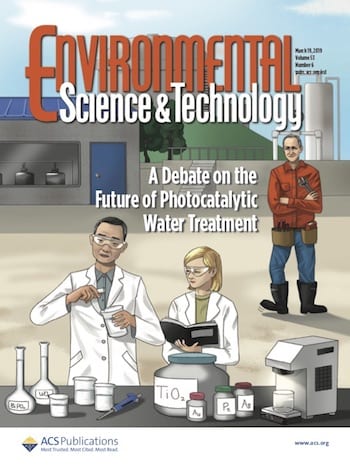Rice-based center takes hard look at practical use of process for water remediation
More than three decades ago, when researchers began exploring photocatalysis as a way to purify water, efforts were buoyed by a wave of optimism within academia.
But an abundance of research — more than 8,000 research papers since 2000 — hasn’t yet translated to widespread industry use.
To take a closer look at this gap, the Rice University-based Nanosystems Engineering Research Center for Nanotechnology Enabled Water Treatment (NEWT) organized a workshop last year to take a hard look at the technology and assess its real-world value.
The workshop served as the basis for a new paper in the American Chemical Society journal Environmental  Science & Technology that explores how to best direct research efforts in this area. The paper also appears online.
Science & Technology that explores how to best direct research efforts in this area. The paper also appears online.
The workshop assembled 14 leading researchers in the field, including NEWT Director Pedro Alvarez, Rice’s George R. Brown Professor of Civil and Environmental Engineering, for a daylong brainstorming session last March. They shared their ideas on potential applications of the technology, its limitations and best real-world uses for it.
“This is an effort by NEWT to be thought leaders and to steward the research community to areas of highest impact, of greatest need,” Alvarez said.
He said part of the center’s mission is to take an honest look at the research it conducts to discern between “academic hype” and work likely to produce important such societal benefits as water security. The paper is part of that effort.
“There was a point where we noticed there was not enough ‘pull’ from our industrial partners, despite the many high-impact papers we were generating, and decided to investigate this disconnect,” he said.
“Photocatalysis is one of those examples,” Alvarez said. “It attracts a lot of research findings, and a lot of research activity. There is a significant number of papers being published in this area with an exponential trend, in terms of the increasing number of publications.”
The researchers focused on photocatalytic advanced oxidation processes (AOP) that treat water by breaking down contaminants. Unlike conventional AOPs, photocatalysis doesn’t require chemicals. And because it requires only low-energy UV light, there are potential solar applications. The standard material for semiconductors is titanium dioxide, which is inexpensive and relatively safe. These properties promised a revolutionary new way to treat water.

Pedro Alvarez
The paper refers to the early years of photocatalysis research as its “sunrise” phase; that is, when excitement by the subject’s potential fuels a vast body of research. Having gone beyond that phase, it is now time to take a more measured approach, said lead author Jaehong Kim, the Henry P. Becton Sr. Professor and chair of chemical and environmental engineering at Yale.
“We recognize the large disparity between academic research and industry application,” said Kim, who stressed the paper isn’t meant to discourage research about photocatalysis but to serve as a “reality check” and offer guidance on possible directions to take it.
Alvarez agreed. “We did find several niche applications where photocatalysis could be very feasible, and it makes a lot of sense, particularly in resource-limited areas where you have limited infrastructure and you need something easy to deploy,” he said. “You need something that can take advantage of sunlight where you have an urgent need for water disinfection or destruction of some common organic pollutants.
“A second area where I believe it makes sense, along with other advanced oxidation processes, is in the selective destruction of endocrine disruptors in other pharmaceutical compounds in the effluent of wastewater treatment plants,” he said. “I think we should focus on strategies to trap and zap priority pollutants for more efficient utilization of the reactive oxygen species that are being generated by photocatalytic systems. This would enhance the kinetics and lower the energy requirements of photocatalytic treatment.”
The researchers offered suggestions as to how the technology might be best used. Specifically, they point to niche applications, such as hydroponics and aquaculture, which are usually practiced on a small scale.
“We aim to do research that is distinctive, credible and high-impact,” Alvarez said. “We try to align those three axioms, and sometimes we need to hear from other experts that are not affiliated with our center to fine-tune direction. That is one motivation for these workshops.”
NEWT is an interdisciplinary, multi-institution nanosystems-engineering research center headquartered at Rice that is applying nanotechnology to develop off-grid water treatment systems that both protect human lives and support sustainable economic development. In addition to Yale and Rice, NEWT’s leadership includes experts from Arizona State University, the University of Texas at El Paso and more than 30 industry and government partners.

